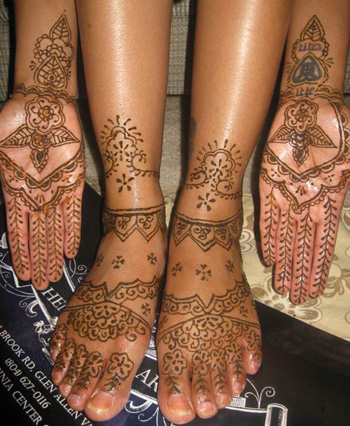Contents:
Common Names | Parts Usually Used | Plant(s) & Culture | Where Found | Medicinal Properties
Legends, Myths and Stories | Uses | Bibliography
Scientific Names
 |
- Lawsonia inermis L.
- Lawsonia alba
- Loosestrife family
Common Names
- Alcanna
- Egyptian privet
- Henna plant
- Jamaica mignonette
- Jan-chih-chia-ts’ao (Chinese name)
- Mignonette tree
- Reseda
Parts Usually Used
Leaves, root
Back to Top
Description of Plant(s) and
Culture
Henna is a small shrub, the grayish-green leaves are elliptical and from 1-2 inches long. Fragrant red flowers highly prized by Egyptian ladies, grow in large panicles.
Back to Top
Where Found
Henna grows in Arabia, North Africa, Iran, and the East Indies.
Back to Top
Medicinal Properties
Astringent
Back to Top
Legends, Myths and Stories
 |
Few women of today realize that they are using an herb used by women in Cleopatra’s time and for thousands of years before in Egypt. The ladies of those remote times used Henna for dyeing their finger and toe nails also. Even the men used the herb for dyeing their beards and coloring the manes and tails of their horses. These methods were not approved of by other peoples according to this ancient writing which states in regards to captured ladies of the ancient civilization: “Then thou shalt bring her home, to thine house; and she shall shave her head and pare her nails.” So strong was the prejudice against dyeing hair that women of Europe did not use Henna until the very late 19th century. From the fashion centers of Vienna and Paris, the use of Henna spread rapidly over the world.
Henna is simple to prepare. The fine cut leaves or powdered leaves are made into a paste with hot water and applied to the hair and allowed to remain until the desired shade is obtained. On finger or toe nails the paste is allowed to remain over-night or paste is renewed often until the desired shade is obtained. Plain Henna adds an auburn shade to the nails. Various shades may be obtained by mixing Henna with Indigo, Sage, or other dye plants.
Henna is not only the oldest known hair rinse in the world but is the most widely used as well. The old texts remind us that “when dyeing (the hair), consider color of your eyebrows, complexion, etc., in order to get a harmonizing and natural appearance. Henna dye shows the color more after the second day of application.” Shampoo the hair before using the hair dye.
Uses
A decoction made from the leaves is used as a gargle and, taken internally or used externally, for skin problems. Also, sometimes it is taken as a headache remedy. The leaves can be used internally or externally for jaundice, leprosy, and psoriasis. The bark is used as a dye.
Back to Top
Bibliography
![]() Back to Eden
Back to Eden, by Jethro Kloss; Back to Eden Publishing Co., Loma Linda, CA 92354, Original copyright 1939, revised edition 1994
![]() Chinese Medicinal Herbs
Chinese Medicinal Herbs, compiled by Shih-Chen Li, Georgetown Press, San Francisco, California, 1973.
![]() The Herbalist Almanac
The Herbalist Almanac, by Clarence Meyer, Meyerbooks, publisher, PO Box 427, Glenwood, Illinois 60425, copyright 1988, fifth printing, 1994
![]() The Herb Book
The Herb Book, by John Lust, Bantam Books, 666 Fifth Avenue, New York, NY. copyright 1974.
![]() The Yoga of Herbs: An Ayurvedic Guide to Herbal Medicine
The Yoga of Herbs: An Ayurvedic Guide to Herbal Medicine, by Dr. David Frawley & Dr. Vasant Lad, Lotus Press, Twin Lakes, Wisconsin, Second edition, 1988.
![]() Webster’s New World Dictionary
Webster’s New World Dictionary, Third College Edition, Victoria Neufeldt, Editor in Chief, New World Dictionaries: A Division of Simon & Schuster, Inc., 15 Columbus Circle, New York, NY 10023
